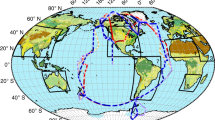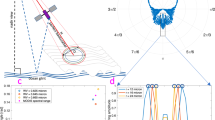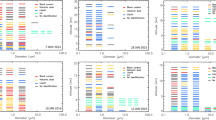Abstract
Dry fogs appear in the atmosphere when large volcanic eruptions inject massive quantities of fine silicate ash and aerosol-forming sulphur gases into the troposphere and stratosphere. Although the ash gravitationally settles out within weeks, the aerosols spread around the globe and can remain suspended in the stratosphere for years. Because solar radiation is easily absorbed and backscattered by the volcanic particles, a haziness in the sky and a dimming of the Sun and Moon are produced. Very dense and widespread dry fogs occur, on the average, once every few centuries1–3. The sizes and intensities of some of the largest of them before the modern scientific era have been estimated by several indirect methods2,4,5. The densest and most persistent dry fog on record was observed in Europe and the Middle East during AD 536 and 537. Despite the earliness of the date, there is sufficient detailed information to estimate the optical depth and mass of this remarkable stratospheric dust cloud. The importance of this cloud resides in the fact that its mass and its climatic consequences appear to exceed those of any other volcanic cloud observed during the past three millenia. Although the volcano responsible remains a mystery, a tropical location (perhaps the volcano Rabaul on the island of New Britain, Papua New Guinea) can be tentatively inferred.
This is a preview of subscription content, access via your institution
Access options
Subscribe to this journal
Receive 51 print issues and online access
$199.00 per year
only $3.90 per issue
Buy this article
- Purchase on Springer Link
- Instant access to full article PDF
Prices may be subject to local taxes which are calculated during checkout
Similar content being viewed by others
References
Russell, F. A. R. The Eruption of Krakatoa and Subsequent Phenomena (ed. Symons, G. J.) 384–405 (Truebner, London, 1888).
Lamb, H. H. Phil. Trans. R. Soc. A266, 425–533 (1970).
Stothers, R. B. & Rampino, M. R. Science 222, 411–413 (1983).
Deirmendjian, D. Adv. Geophys. 16, 267–296 (1973).
Hammer, C. U., Clausen, H. B. & Dansgaard, W. Nature 288, 230–235 (1980).
Stothers, R. B. & Rampino, M. R. J. geophys. Res. 88, 6357–6371 (1983).
Procopius History of the Wars (transl. Dewing, B. H.) 2.4.1–2, 4.14.5–6 (Harvard University Press, Cambridge, Massachusetts, 1916).
Lydus, J. L. On Portents (ed. Wachsmuth, C.) 9c (Teubner, Leipzig, 1863).
Zacharias of Mytilene Chronicle (transl. Hamilton, F. J. & Brooks, E. W.) 9.19, 10.1 (Methuen, London, 1899).
Michael the Syrian Chronicle (transl, (into French) Chabot, J.-B.) 9.296 (Belles-Lettres, Paris, 1901).
Bar-Hebraeus Chronography (transl. Budge, E. A. W.) 8.79–80 (Oxford University Press, London, 1932).
Minnaert, M. The Nature of Light and Colour in the Open Air (transl. Kremer-Priest, H. M. & Jay, K. E. B.) 55, 269 (Dover, New York, 1954).
Allen, C. W. Astrophysical Quantities, 125–127 (Athlone, London, 1973).
Blanco, V. M. & McCuskey, S. W. Basic Physics of the Solar System, 93 (Addison-Wesley, Reading, Massachusetts, 1961).
Heming, R. F. Bull. geol. Soc. Am. 85, 1253–1264 (1974).
Walker, G. P. L., Heming, R. F., Sprod, T. J. & Walker, H. R. Geol. Surv. Papua New Guinea Mem. 10, 181–193 (1981).
Seltzer, L. E. (ed.) The Columbia Lippincott Gazetteer of the World, 1309 (Columbia University Press, New York, 1952).
Herron, M. M. J. geophys. Res. 87, 3052–3060 (1982).
Stothers, R. B. Science (in the press).
Ho Peng Yoke Vistas Astr. 5, 127–225 (1962).
John of Ephesus Ecclesiastical History (transl, (into Latin) van Douwen, W. J. & Land, J. P. N.) 297–298 (Muller, Amsterdam, 1889).
Post, J. D. The Last Great Subsistence Crisis in the Western World, 55–59 (Johns Hopkins University Press, Baltimore, Maryland, 1977).
Author information
Authors and Affiliations
Rights and permissions
About this article
Cite this article
Stothers, R. Mystery cloud of AD 536. Nature 307, 344–345 (1984). https://doi.org/10.1038/307344a0
Received:
Accepted:
Issue Date:
DOI: https://doi.org/10.1038/307344a0
This article is cited by
-
Lunar eclipses illuminate timing and climate impact of medieval volcanism
Nature (2023)
-
Modern aridity in the Altai-Sayan mountain range derived from multiple millennial proxies
Scientific Reports (2022)
-
Recurrent transitions to Little Ice Age-like climatic regimes over the Holocene
Climate Dynamics (2021)
-
Disproportionately strong climate forcing from extratropical explosive volcanic eruptions
Nature Geoscience (2019)
-
Geo-cultural Time: Advancing Human Societal Complexity Within Worldwide Constraint Bottlenecks—A Chronological/Helical Approach to Understanding Human–Planetary Interactions
BioPhysical Economics and Resource Quality (2019)
Comments
By submitting a comment you agree to abide by our Terms and Community Guidelines. If you find something abusive or that does not comply with our terms or guidelines please flag it as inappropriate.



